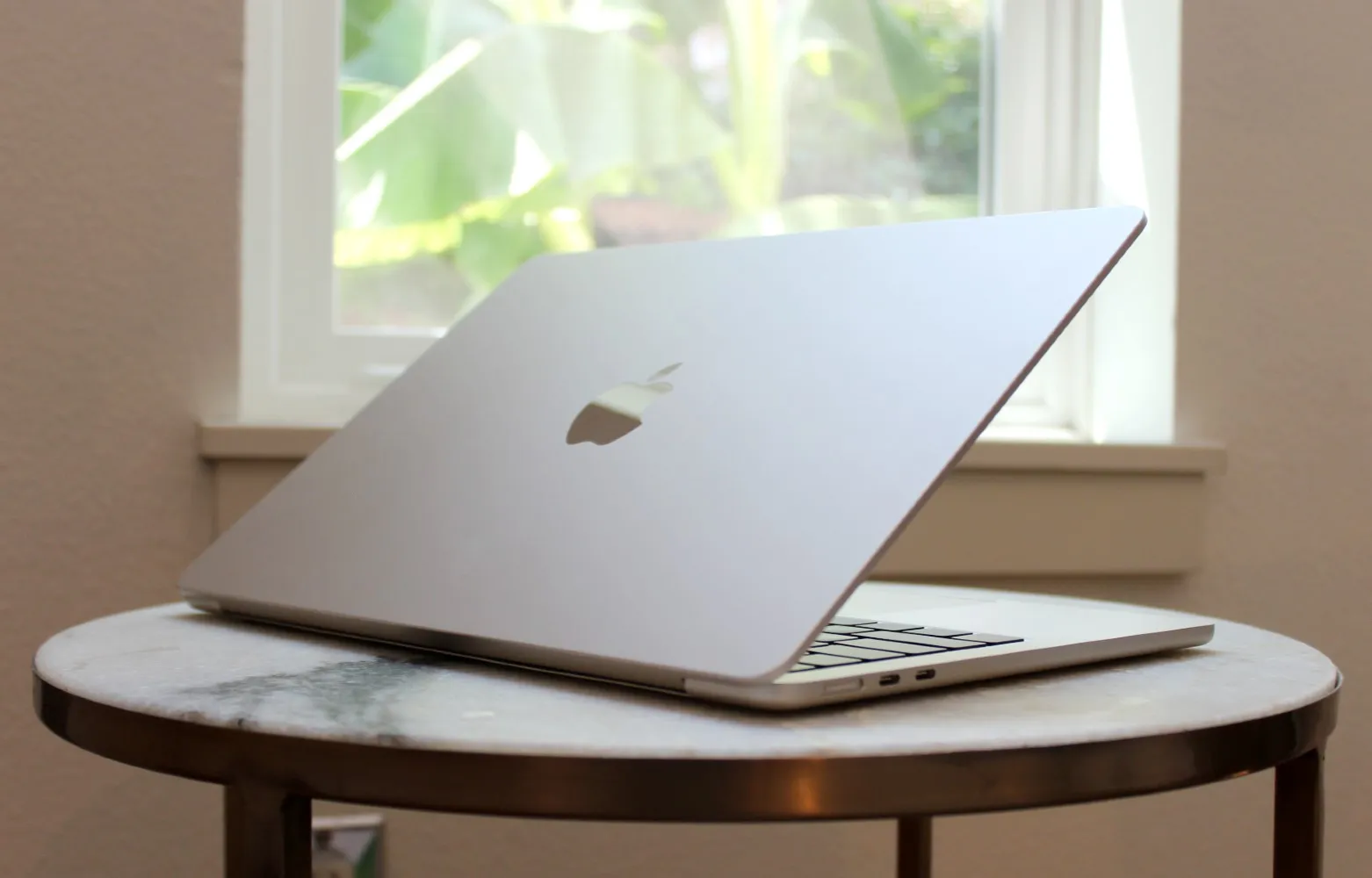
Apple MacBook Air (M2)
MSRP $1,199.00
“The M2 MacBook Air balances size and performance in a way no other laptop can.”
Pros
- Incredibly thin
- Upgraded webcam and speakers
- Shockingly good performance
- Battery life stomps the competition
- Screen and keyboard are world-class
Cons
- Worryingly hot internal temperatures
- Still only supports one monitor
The M2 MacBook Air is more than just another MacBook. It’s the laptop Apple has wanted to make for many, many years — but couldn’t, due to the limitations of the hardware.
But with the M2 intact, Apple’s created the thinnest usable laptop ever made. It’s completely fanless and with no discernible compromises. What more could Mac fans want from the latest MacBook Air?
It’s not a laptop without some self-created controversies, but the M2 MacBook Air nails the experience Apple has always wanted to create with its smaller laptops. And for the right person, it’s downright sublime.
Design

The M2 MacBook Air isn’t as big of a departure from the formula as it was originally rumored to be. No white bezels or fanciful color options. I was a little disappointed at first, but putting my desire for an exciting change aside, the safer design was probably a good move for Apple, especially considering all the outrage around the controversial M1 iMac.
Besides, all these more low-key tweaks to the MacBook Air are benefits over the previous model. In general, the chassis now carries the same general shape as the 14-inch and 16-inch MacBook Pro. That means the corners are more rounded, the lid cover is flat, and, of course, there’s a notch in the display.
The thinness of this laptop is showstopping.
Those are the obvious changes, but there are some even subtler design changes that you might not notice at first glance. The flatter rubber feet on the bottom have been carried over from the MacBook Pro, as have the rounded corners of the screen itself. It even gets the larger row of function keys that I enjoyed on the MacBook Pro.
But this is a MacBook, and it certainly still looks like one. What makes this special is what it feels like. It’s a minimal 0.44 inches of metal between your hands when you set it on the table and 2.7 pounds of weight when you toss it in your bag.
The thinness of this laptop, in particular, is incredible. I love how comfortable it is to use on a desk, and even with how thin it is, there’s never even a hint of flex. The hinge opens with one finger as MacBooks always do.
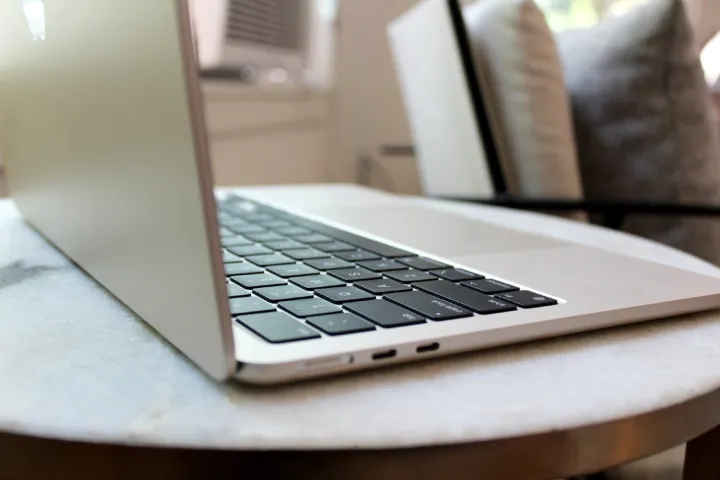
That’s the feeling of a MacBook Air redesigned around the extreme efficiency afforded by the M-series chips.
There’s a reason you’ll be hard-pressed to find another laptop this thin — at least, not one without some significant deficiencies. Never has a laptop this small been matched with this amount of performance, and the switch to Apple Silicon is what makes it all possible. Conventional Intel and AMD-based systems have a long way to go.
Keyboard and trackpad
The new MacBook Air doesn’t make any major changes to the trackpad or keyboard than what’s been in recent MacBooks. The traditional scissor mechanism used here is lovely and familiar to type on. No learning curve here whatsoever.
The keycaps don’t wiggle and are backlit by bright white LEDs with tons of brightness control. Most Windows laptops give just a few levels of brightness control, but MacOS gives you an entire slider of adjustments. Unfortunately, this has now been hidden away in the Menu Bar rather than being given a dedicated key in the function row like in the past.
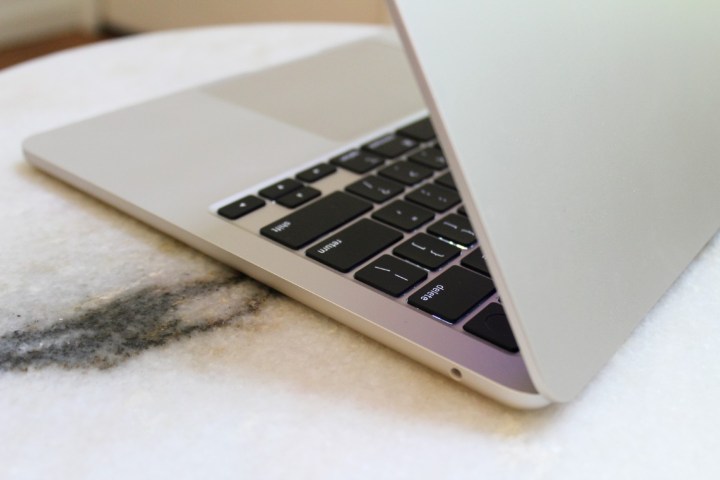
This is, of course, because the function keys are now full-sized rather than half-sized. I think I’d prefer keyboard backlighting to have a dedicated key instead of sleep or spotlight, but hey, that’s just me. As a whole, it’s a net positive to have these larger function keys.
The Touch ID fingerprint reader is still found in the top right of the layout, on top of the power button.
The haptic feedback trackpad is the same oversized Force Touch one that’s featured in the M1 MacBook Air. It’s extremely precise, never struggling with accidental clicks or palm rejection. Even as similar haptic touchpads have begun to roll out in Windows laptops like the Dell XPS 13 Plus or Surface Laptop Studio, MacBooks remain the best in the business.
Ports
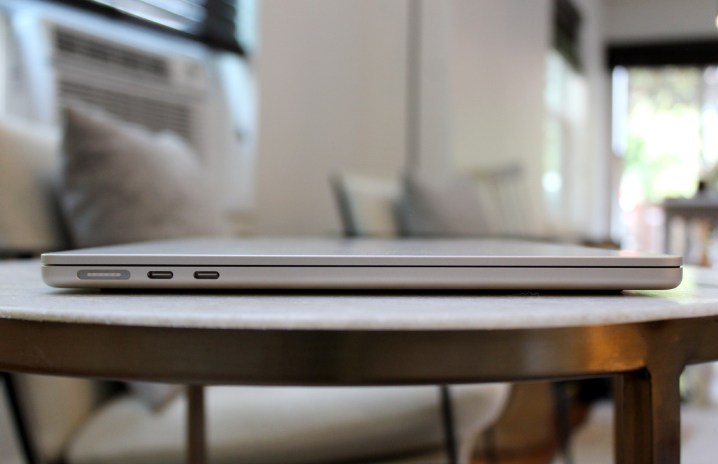
The M2 MacBook Air has received an upgrade in port selection over the previous model. On the left, you’ll find two USB-C ports and a MagSafe 3 charging port. This is the same slimmed-down MagSafe port as was found in the MacBook Pro. On the right side, there’s a headphone jack.
I do wish they’d split the USB-C ports so there’s one on each side for more convenient charging.
While things like HDMI and SD card slots are reserved for the MacBook Pro, it’s nice to at least have the additional charging port to free up the USB-C ports for other uses. Having both USB-C ports available doesn’t, however, mean you can hook up two external displays. Like the M1 MacBook Air, this laptop can only connect to one external display (with up to a 6K resolution) at a time.
The MacBook Air supports Wi-Fi 6 and Bluetooth 5.0 for wireless connectivity. These are the latest standards that Apple currently supports in its laptops, but premium Windows laptops have since moved to Wi-Fi 6E and Bluetooth 5.2.
Display
The MacBook Air’s 13.6-inch panel is what Apple classifies as a “Liquid Retina” display, meaning it’s a newer LCD technology that allows for higher pixel density and a wider color gamut than the standard Retina displays, as found in the M1 MacBook Air and the M2 MacBook Pro.
In reality, it’s not too big of an upgrade, though. The panel has a 2560 x 1664 resolution, which equates to 224 ppi (pixels per inch). That’s not quite as sharp as the “3.5K” configuration of the Dell XPS 13 Plus, for example, which hits 304 ppi – and it’s just barely less pixel-dense than the 13-inch MacBook Pro due to its larger screen size.
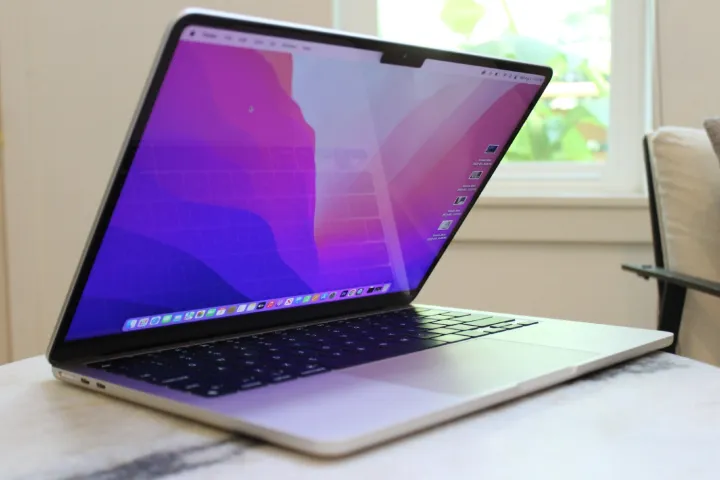
That extra 0.3 inches of screen real estate is thanks to some dramatically decreased bezels. It’s still a 16:10 aspect ratio, but the smaller bezels allow for more screen in the same footprint, similar to what Apple did with its larger MacBook Pros. And that means the inclusion of a notch, too.
The difference between this and the 14-inch MacBook Pro is substantial. The incredible HDR performance is a no-go here, and you’ll have to pay big bucks for that mini-LED XDR display.
But what you get here is a very solid display for a laptop at this price. It’s brighter than most Windows laptops at a max of 486 nits, and the colors are brilliant, with a wide gamut (90% AdobeRGB, 100% sRGB) and good color accuracy (Delta-E of 1.08). It’s no longer the leader, especially not against the OLED 4K laptops out there, but it remains a great panel for the price.
Speakers and webcam
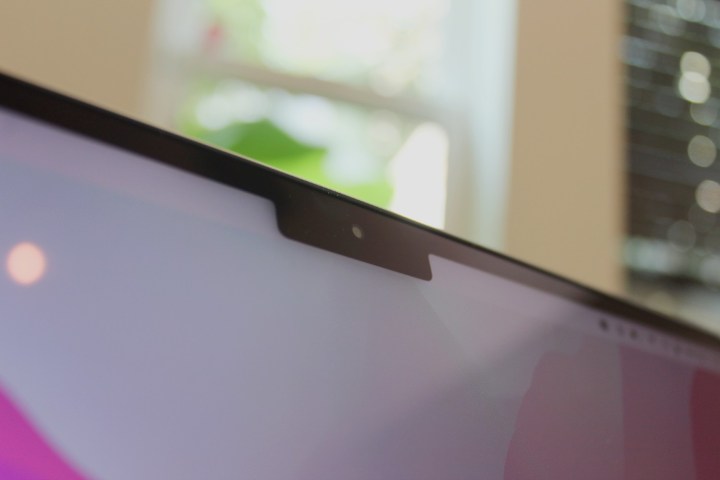
Apple continues to have the best speakers on its laptops, at least compared to the competition. The M2 MacBook Air uses a four-speaker setup, a bump up from the standard stereo speakers on the M1 MacBook Air. They sound fantastic, especially for a laptop of this size.
Of course, comparing them next to the 14-inch or 16-inch MacBook Pro isn’t totally fair. Those laptops manage to conjure up a healthy amount of bass, while it’s still lacking in the MacBook Air. Still, these are the best speakers you’ll find on a 13-inch laptop.
The MacBook Air also uses an upgraded 1080p FaceTime webcam. This matches the trend in the industry toward higher-resolution webcams, and what the larger MacBook Pros have. And thanks to the neural engine in the M2, the image processing is excellent, ensuring that your face is always in focus and not overexposed — regardless of the lighting situation. It’s certainly among the best video conferencing laptops you can buy.
Like all Macs, the MacBook Air still doesn’t have Face ID, unfortunately.
Performance
The new MacBook Air also includes a next-generation chip, the M2. Although Apple is trying to sell this as a true sequel to the revolutionary M1, the rollout of this new chip has felt a little strange. It was announced at WWDC 2022 and has initially shown up in just two devices: 13-inch MacBook Pro and MacBook Air.
Behind the scenes, we know why. Reports indicated that what was originally intended to be the true M2 had been delayed due to manufacturing issues surrounding its production. Rather than skipping to a 3nm TSMC node, Apple was stuck working with a “refined” 5nm node. So, the M2 became the M3, and the M2 became a more iterative update to the M1.
But none of that matters if Apple is able to crank out enough performance to make the M2 feel like a worthy upgrade, right? It’s particularly important since Apple still sells the M1 MacBook Air for $300 cheaper.
| Geekbench (single / multi) |
Handbrake (seconds) |
Cinebench R23 (single / multi) |
Pugetbench Premiere Pro | |
| MacBook Air (M2) | 1,925 / 8,973 | 151 | 1,600 / 7,938 | 497 |
| MacBook Air (M1) | 1,727 / 7,585 | 156 | 1,479 / 6,680 | 320 |
| Dell XPS 13 Plus (Core i7-1280P) | 1,316 / 8,207 | 170 | 1,311 / 6,308 | 269 |
| HP Spectre x360 13.5 (Core i7-1255U) | 1,566 / 7,314 | 169 | 1,623 / 5,823 | n/a |
| Lenovo ThinkPad X1 Yoga Gen 7 (Core i7-1260P) |
1,650 / 8,080 | 116 | 1,587 / 7,682 | n/a |
| MacBook Pro 14-inch (M1 Pro) | 1,760 / 1,2307 | 99 | 1,624 / 12,235 | 911 |
Tested in benchmarks, the new MacBook Air maintains a decent bump up over the M1 MacBook Air. In Geekbench 5, it scores 11% higher in single-core performance and 18% higher in multi-core. That verifies the 18% claim that Apple made, so props to the marketing team for not trying to stretch things further.
That’s not going to blow your socks off. There will, in all likelihood, be very little discernible performance difference between working on an M2 MacBook Air and on an M1 MacBook Air. That’s normal for raw performance in generational CPU upgrades, but it shows just how substantial the M1 really was. And none of that goodness is lost with the M2. It’s still insanely efficient, and even in a completely fanless system, delivers incredible performance.
The biggest enhancement to the M2 MacBook Air’s performance is the improved neural engine and media engine. The higher-bandwidth video decoder and ProRes video engine should make the M2 MacBook Air a better video editing machine. I put this to the test in the PugetBench Premiere Pro benchmark, which tests everything from video playback to export times. It would also test the capabilities of the GPU, which hypothetically show the impact of the two extra GPU cores that Apple charges an extra $100 for.
The trade-off for all this extra performance is in heat.
The M2 received a 36% higher score for applying GPU effects than the M1 MacBook Air. The CPU and GPU also worked together to produce 51% faster export times — and hey, that’s a difference you might actually notice. Of course, moving up to the M1 Pro in the 14-inch MacBook Pro is still a large leap, especially in multi-core performance and GPU performance — just a bit less now that the M2 stands in the gap.
The trade-off for all this extra performance is in heat. I saw CPU cores spike to as high as 108 degrees Celsius on full load. This is way too hot. Intel laptops usually don’t allow temperatures to get above 100 degrees for safety concerns. There are some concerns about the long-term durability of seeing temperatures this high — which is clearly something Apple doesn’t expect you to do. The thermal issues were a problem noticed first in the M2 MacBook Pro, with Apple very slowly ramping up the use of fans. In the case of the M2 MacBook Air, which is fanless, Apple letting temperatures get too hot, pushing more power into this system than it can really handle. This is all in service of hitting the performance delta it needed for marketing purposes, even if Apple should probably be throttling frequencies a bit lower to keep the temperatures down.
As far as surface temperatures go, the bottom of the laptop does get quite warm under full load. But what the MacBook Air continues to do so well is keep those hot spots away from your hands. The palm rests and keyboard stay cool pretty much no matter what. The system also cools down remarkably fast. Compared to the lingering warm temperatures in something like the XPS 13 Plus, that’s a huge benefit.
Configuration issues
Normally, the option of which configuration of MacBook you buy largely has to do with how much storage and memory you need. You get something high quality regardless of what you choose, though. With the M2 MacBook Air, though, that doesn’t seem to be the case.
I received the same review unit that many reviewers have tested, which is the $1,499 model that comes with 8GB of RAM and a 512GB SSD. This model also comes with a 10-core GPU.

But as has been pointed out by eagle-eyed YouTuber, Max Tech, there have been some serious performance issues with the base model. The combination of the significantly slower storage, due to it having just a single NAND chip, and the limit of 8GB of RAM seems to cause a massive slowdown in certain tasks — specifically those that rely heavily on memory. In real-world tasks like exporting images out of Lightroom or transferring files from an external SSD, the base configuration seems to be exponentially slower.
The configuration I tested, of course, doesn’t suffer from these kinds of issues. The 512GB storage The shared 8GB of RAM will certainly be a limitation, which can easily be noted by watching Activity Monitor. And yet, while running the multi-core Cinebench rest, had 15 heavy Chrome tabs open, Spotify stream music, and a YouTube video playing — and didn’t see a significant slowdown. That was all while being unplugged, too.
If you’re buying a laptop solely for web browsing, social media, and watching Netflix, you’ll probably even be fine on that base configuration. Because this is a MacBook Air (and not a MacBook Pro), Apple will likely get away with cutting corners on its SSD with few complaints — other than from reviewers.
But if you intend to use your MacBook Air for anything mildly taxing, even some light photo editing or graphic design on the side, you’ll be much happier opting for at least the $200 upgrade up to the 512GB model. $1,399 is still a decent value for this machine, even without the extra GPU cores and memory.
Battery life
Battery life continues to be an area where MacBooks have a clear and undeniable lead. While ARM-based Windows laptops also get better battery life, their performance is still way behind. The MacBook Air manages to have both, and that still feels like a revelation, even almost two years since the M1 was launched.
The MacBook Air M2 lasted just under 18 hours in our web browsing test, which cycles through a series of heavy websites until the machine dies. That’s well over double nearly all of its competitors — and it’s in line with what the M1 MacBook Air could do. Amazingly, the MacBook Pro 16-inch lasts even longer.
To test the maximum capacity of the battery, I ran a looped 1080p video on the laptop until the battery died. It lasted an astounding 21 hours and 9 minutes in this test. Again, this is in a different league compared to its competitors.
What that means is you’ll have no problem making it through a full day of work away from the wall. On a lighter day, it could even make it through two days.
Our take
Only Apple could make the M2 MacBook Air. No other laptop balances performance with chassis size like the MacBook Air, all while featuring top-of-the-line components, ranging from the webcam to the keyboard.
The base configuration appears to have some deficiencies, yes. And Apple appears to have pushed too hard for better performance at the expense of the machine itself. But I’m still in awe of what the M2 MacBook Air can do, and at a price that isn’t too far off from much worse laptops.
Are there any alternatives?
The M1 MacBook Air stands as the biggest hurdle. It’s still the laptop most people should choose, especially since the performance isn’t worth upgrading to the M2 model — and neither is one single aspect of the new design. There’s also the M2 MacBook Pro, but the M2 Air is a far better purchase.
On the Windows side of the fence, the closest competitors are the Dell XPS 13 Plus, the HP Spectre x360 13.5, and the Microsoft Surface Laptop 4. None have the battery life or performance of the MacBook Air but stand as its closest rivals.
How long will it last?
The MacBook Air should last you many, many years. These M-series chips are so ahead of the competition, you may find yourself happy with the performance four or five years down the road. There have been some concerns with the long-term durability of the MacBook Air’s memory and storage, and because everything is soldered down, nothing can be easily replaced.
Should you buy it?
Yes. Choosing the correct configuration has never been so important, but in terms of size, battery life, and performance, the M2 MacBook Air is a laptop unlike any other you can buy.
Editors’ Recommendations




